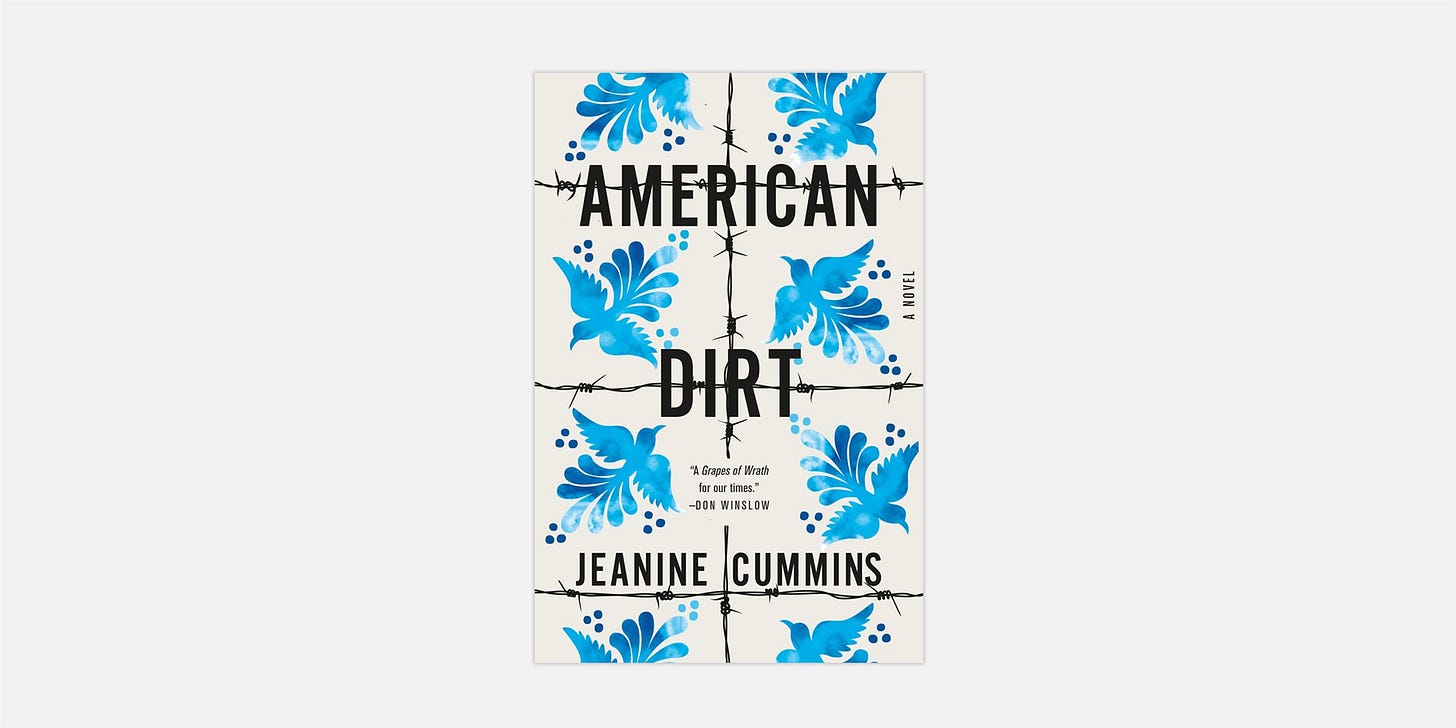Welcome to Much 2 Consider, a new semi-regular column from John Paul Brammer wherein he unpacks something cursed, complicated, or current in a vain attempt to make sense of it. This time, it’s about the hoopla around “American Dirt.” ¡Ay caramba! Subscribe to get ¡Hola Papi! and more essays like this delivered right to your inbox!

The Latin American tradition of magical realism is primarily a tool to create space. We know the truth is too unwieldy for the rigid confines of reality, so we tilt the world a bit to accommodate it. We suspend certain rules so as to sabotage the ordinary negotiations between what is real and what is true. “American Dirt” is not a work of magical realism, but I can think of few other books that would better benefit from the grace the genre offers. The book buckles under the harsh demands of reality, mostly because it can’t stop evoking them. In doing so, it fails on its own terms.
This isn’t really a review of “American Dirt” by Jeanine Cummins. Other people have written those, and written those well. Here’s one, and here’s another. I’m more interested in discussing “American Dirt’s”troubled relationship with the real world crises it claims to be interested in solving, and how that relationship has poisoned the core of its story, which in another universe would be on par with a perfectly passable season of Narcos or something.
The narrative should be familiar to anyone who has watched or read anything about Mexicans. There are cartels, bullets, blood, and a quinceañera, all within the first few pages. The protagonist, Lydia, and her son, Luca, are on the run from Javier, the drug cartel leader who murdered Lydia’s journalist husband and many other family members. Mother and son find themselves accidental immigrants caught up in the border crisis. Standard fare, or maybe two standard fares stapled together.
Reading the book, I was met with the monumental task of ignoring the noise around it. I had to first ignore the chatter about the author’s identity: she has a Puerto Rican grandmother and has added “Boricua” to her Twitter bio. This is more or less irrelevant, or should be, but like so many other facts surrounding “American Dirt” it insists on being considered, a vague credential to writing a “Latino book.” Sure. I’m not one to play gatekeeper. Bienvenidos (¡bienvenidos!) or whatever. Let’s move on.
Not so fast, says “American Dirt,”because another thing you should know is that this book is a movement of sorts, and reading it is akin to activism. “I wanted to give a face to the faceless brown mass at the border,” the book says. “I’m kind of the next Grapes of Wrath,” the cover itself chimes in. “‘Uvas de Wrath,’ if you will.”
Okay. I’m no stranger to publishing. We put our best blurbs forward. I don’t think “faceless brown mass” is a particularly strategic series of words for a book like this to dispatch. But fine, fine, I’ll draw my own conclusions.
“The barbed wire centerpieces at the launch party were so lovely,” “American Dirt” tells me just as I’m about to wade into chapter one (capítulo uno). “The what?” I ask, and to my horror I discover that “American Dirt” isn’t lying to me and there was, in fact, a launch party with barbed wire centerpieces celebrating this million-dollar book. This is getting to be a chore, but I’m used to chores, and so I somehow push through and finally walk into the world of the book.

“I just wish someone a shade browner than me could have written this,” “American Dirt” adds, getting one last word in before I start, to which I can only respond, “Excuse me?” Prominent media outlets have boiled the discourse around this book down to a discussion over who is “allowed” to write certain books. But if anything, it’s Cummins who insists on essentialism. While brown people are disproportionately impacted by immigration policies, simplifying it to a matter of skin tone seems to be an inadequate model of addressing the matter. Or maybe I should be waiting until summertime to write about Latino things. I don’t know.
What I do know is that upon finally, finally being allowed to get into the meat of the story, I find out that this is only the beginning of “American Dirt’s”obsession with skin. Parul Sehgal of The New York Times put it well in her surgical review: “Characters are ‘berry-brown’ or ‘tan as childhood’… In all my years of hugging my own sister, I don’t think I’ve ever thought, ‘Here I am, hugging your brown neck.’ Am I missing out?”
This fixation could be construed as white lady clumsiness, but I think it’s perfectly in keeping with how oppression is imagined to work through the lens of, for lack of a better term, woke white Twitter: “brown” means “suffering,” and the more we recognize brownness, the more we reference it and pair it with positive things like “sunshine” and “childhood,” the more we are doing the work. “Brown is beautiful!” these sentences scream at me, but I can’t help but couple that with the faux activism the book is so keen on telling me it’s doing.
The conclusion I’ve reached is that “American Dirt” is on a mission of sorts. It’s just that the mission it has set out to accomplish is one that’s working on behalf of imagined Mexicans, problems that gringos think Mexicans have: being faceless, being shot at by evil cartels (themselves, faceless), being caught up in citizenship woes, being on a dangerous, jagged path toward the United States, always toward the United States, the beacon, the saving grace.
To be clear, these are struggles some Mexicans do have, but there’s nothing new about broadly applying them to every Mexican person for the sake of dramatizing the border. In Sexy Señoritas and Other Imperial Fantasies, Myra Mendible writes on the American history of sexualizing Mexico in popular media as a land of rapacious brown men from which the brown women must be saved and redeemed by the grace of the United States (and in another sense, by whiteness).
“As Alfred Charles Richard argues, the overwhelming frequency of films featuring Anglo superiority over his neighbors south of the border fostered a ‘national consciousness that expected to win, to be in charge, to control those shown to be inferiors,’” Mendible writes. This mode of thinking leaves little by way of nuance. The border is a fact of topography rather than a calculated act of human cruelty. The people south of it lead squalid lives in waiting, wishing to be sieved through the border and redeemed, their inferiorities purged.
This way of thinking was outdated decades ago, but perhaps never more so than now, in a time where Mexico is an eager collaborator on the project of rounding up migrants, most of whom are fleeing Central America because of US foreign policies. “American Dirt” isn’t consciously contributing to this flattening (I don’t think), nor should any one novel be tasked with undoing legacies of colonialism and inhumane immigration policies. No one would realistically expect that of a novel.
The problem is, that’s what “American Dirt” has positioned itself as being: a savior book, an urgent story that will humanize the inhuman. We didn’t do that. Latinos hung up on identity politics didn’t do it. “American Dirt” did that. We were told, rather explicitly, that this was the book that would have a huge impact on the problem, and it simply can’t, and so it doesn’t.
I’m not saying that book can’t exist on its own terms or stand alone without the buzz around it. Marginalized people in particular are adept at “killing the author,” as it were (check out this amazing Lindsay Ellis video for more on that). Getting into the actual content of this book would be another essay entirely. What I’m saying is that the paratext of this book has superseded the text, and the book was a willing collaborator to that end.
For this book to be as successful as it has been (Oprah promoted it! That huge advance! And so on!), it has no choice but to marry itself to the miseries and woes of our world. It wouldn’t be an urgent book, an important book, a necessary book without that. But that marriage has baggage. The reality is, our world has been intimately shaped by systems that marginalize the voices of people who actually have been impacted by immigration policies, racism, and imperialism.
We live in a world where there is a real hunger for depictions of nonwhite pain. See the proliferation of images of kids in cages on social media, the twisted voyeurism of the border crisis by both well-meaning allies and bigots alike. For years now, Latino writers have had to wrestle with these struggles, reconcile them with our own identities, turn over stones in pursuit of the truth: in what ways are we impacted, and in what ways might we be complicit? It’s a sometimes traumatic, but always fraught process, one that doesn’t have an end in sight.
If “American Dirt” didn’t want to wade into those troubled waters, then it shouldn’t have cannonballed into the pool. Or la piscina, as mi abuela would call it.



